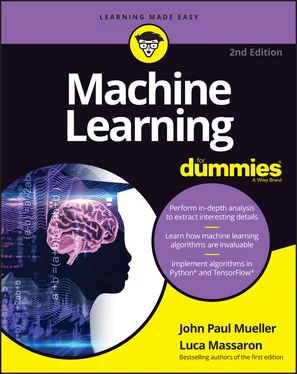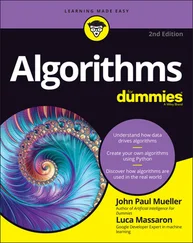Evaluation: The learner can create more than one model. However, it doesn’t know the difference between good and bad models. An evaluation function determines which of the models works best in creating a desired result from a set of inputs. The evaluation function scores the models because more than one model could provide the required results.
Optimization: At some point, the training process produces a set of models that can generally output the right result for a given set of inputs. At this point, the training process searches through these models to determine which one works best. The best model is then output as the result of the training process.
Much of this book focuses on representation. For example, in Chapter 10you discover how to create a working spam detector using the Naïve Bayes algorithm, based on a probabilistic representation of the problem. However, the training process is more involved than simply choosing a representation. All three steps come into play when performing the training process. Fortunately, you can start by focusing on representation and allow the various libraries discussed in the book to do the rest of the work for you.
Chapter 3
Having a Glance at the Future
IN THIS CHAPTER
 Discovering how machine learning will help create useful future technologies
Discovering how machine learning will help create useful future technologies
 Developing new kinds of work as the result of machine learning
Developing new kinds of work as the result of machine learning
 Considering how machine learning can create potential problems
Considering how machine learning can create potential problems
Machine learning technology appears in many products today, but it isn’t even close to complete usability yet. The algorithms used for machine learning today are still relatively basic when compared to what scientists plan to provide for the future. In addition, the data sources for machine learning today are smaller than the datasets planned for future use. In short, machine learning is in its infancy. It already performs a considerable number of tasks amazingly well, however. This chapter looks at what might be possible in the future. It helps you understand the direction that machine learning is taking and how that direction could help entrench machine learning into every aspect of daily life.
One of the issues that comes with a new technology such as machine learning is a fear that machine learning will keep people from working. Quite the contrary: Machine learning will open new occupations that people should find more exciting than working on an assembly line or flipping burgers at a restaurant. One of the goals is to provide creative and interesting work for people to do. Of course, these new jobs will require more and new kinds of training before people can perform them well.
Every new technology also comes with pitfalls. It’s a cliché but true that it’s easier to destroy than to create. The potential pitfalls of machine learning need to be taken seriously. Because this technology is in its infancy, now is the time to consider the potential pitfalls and do something about them before they materialize. The last section of the chapter doesn’t discuss problems that will happen; rather, it discusses problems that could happen and that people can certainly avoid by using the technology correctly.
Creating Useful Technologies for the Future
To survive, a technology must prove useful. In fact, it must prove more than useful; it must meet perceived needs in a manner that existing technologies don’t as well as build a base of adherents who provide a monetary reason to continue investing in the technology. For example, the Apple Lisa was an interesting and useful piece of technology that demonstrated the usefulness of the GUI to business users who had never seen one before. It solved the need to make computers friendly. However, it failed because it didn’t build a base of adherents. The computer simply failed to live up to the hype surrounding it (see https://www.inexhibit.com/case-studies/different-fate-apples-lisa-macintosh-design-matters/ for details). The next system that Apple built, the Macintosh, did live up to the hype a bit better — yet it built on the same technology that the Lisa used. The difference is that the Macintosh developed a considerable array of hard-core adherents.
Machine learning solves a considerable number of problems in a manner that other technologies would have a hard time copying. However, to become the must-have technology that everyone wants to invest in, machine learning must build that cadre of hard-core adherents. The bar chart at https://www.grandviewresearch.com/industry-analysis/machine-learning-market shows that machine learning is growing significantly, with services leading the way. The associated free downloadable report (you must fill in a request to get it) details just how much machine learning has grown in the past few years. The following sections discuss some of the ways in which machine learning is already affecting you personally and how this use will increase in the future — making machine learning a must-have technology.
Considering the role of machine learning in robots
A goal of machine learning today is to create useful, in-home robots. Now, you might be thinking of something along the lines of Rosie the robot found in The Jetsons (see https://thejetsons.fandom.com/wiki/Rosey for a quick description). However, real-world robots need to solve practical and important problems to attract attention. To become viable and attract funding, a technology must also amass a group of followers, and to do that, it must provide both interaction and ownership. According to MarketsAndMarkets (see https://www.marketsandmarkets.com/Market-Reports/household-robot-market-253781130.html ), the market for home robots will go from $1.2 billion in 2016 to $3.3 billion in 2019 (estimated) to $9.1 billion by 2024 (predicted), so home robots are becoming popular.
An example of a successful in-home robot is the Roomba from iRobot ( https://www.amazon.com/exec/obidos/ASIN/B005GK3IVW/datacservip0f-20/ ). You can actually buy a Roomba today; it serves a useful purpose; and it has attracted enough attention to make it a viable technology. The Roomba also shows what is doable at a commercial, in-home, and autonomous level today. Yes, the Roomba is a fancy vacuum cleaner — one with built-in smarts based on simple but very effective algorithms. The Roomba can successfully navigate a home, which is a lot harder to accomplish than you might think. It can also spend more time on dirtier areas of the home. However, you still need to empty the Roomba when full; current robot technology does only so much. (And, just in case you’re interested, you can also find the WORX robotic mower on Amazon at https://www.amazon.com/exec/obidos/ASIN/B07VC44C68/datacservip0f-20/ .)
 You can find other real-world robots that people are using to perform specialized tasks, but you won’t find them in your home. The video at
You can find other real-world robots that people are using to perform specialized tasks, but you won’t find them in your home. The video at https://www.youtube.com/watch?v=PfvXKXSAsUM shows 15 humanoid robots that are interesting, but not particularly useful today (still, you have to admit that they’re fun to look at). Other sites, such as https://shareably.net/70-robots-that-actually-exist/ and https://www.cnn.com/2020/09/23/asia/japan-gundam-robot-test-scli-intl-scn/index.html , present other robots, but you won’t find general-purpose uses in any of them. Before robots can enter a home and work as a generalized helper, machine learning needs to solve a wealth of problems, and the algorithms need to become both more generalized and deeper thinking. By now, you should see that robots will become a part of daily life, but it won’t happen right away.
Читать дальше

 Discovering how machine learning will help create useful future technologies
Discovering how machine learning will help create useful future technologies You can find other real-world robots that people are using to perform specialized tasks, but you won’t find them in your home. The video at
You can find other real-world robots that people are using to perform specialized tasks, but you won’t find them in your home. The video at 










